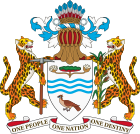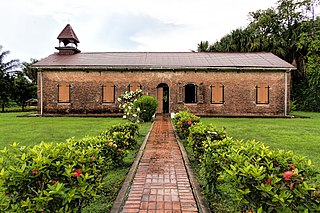 |
|---|
| Constitution |
General elections were held in British Guiana on 3 September 1935.
 |
|---|
| Constitution |
General elections were held in British Guiana on 3 September 1935.
The elections were held in accordance with the 1928 constitution, which established the Legislative Council, reducing the proportion of elected members and increasing the number of members appointed by the government. [1] The 30-member Legislative Council consisted of the Governor, two ex-officio members, eight official members, five unofficial members and 14 members elected in single-member constituencies. [2]
| Constituency | Elected member | ||
|---|---|---|---|
| Berbice River | Joseph Eleazar | ||
| Central Demerara | John Ignatius De Aguiar | ||
| Demerara-Essequibo | Jung Bahadur Singh | ||
| Demerara River | Arthur George King | ||
| Eastern Berbice | Edward Alfred Luckhoo | ||
| Eastern Demerara | Hubert Chester Humphrys | ||
| Essequibo River | Alfred Railton Crum Ewing | ||
| Georgetown Central | Percy Claude Wight | ||
| Georgetown North | Frederick Jacob Seaford | ||
| Georgetown South | Joseph Gonsalves | ||
| New Amsterdam | Eustace Gordon Woolford | ||
| North Western District | Charles Ramkissoon Jacob | ||
| Western Berbice | Peer Bacchus | ||
| Western Essequibo | Sydney Howard Seymour | ||
| Source: Parliament of Guyana | |||
The first meeting of the newly elected Council was held on 15 October. [2] As there were no elections until 1947, the elected Legislative Council became known as the "Long Parliament". [3]

The politics of Guyana takes place in a framework of a representative democratic assembly-independent republic, whereby the President of Guyana is the head of government and of a multi-party system. Executive power is exercised by the President, advised by a cabinet. Legislative power is vested in both the President and the National Assembly of Guyana. The judiciary is independent of the executive and the legislature.

The prime minister of the Co-operative Republic of Guyana is an elected member of the National Assembly of Guyana who is the principal assistant and advisor to the president as well as the leader of government business in the Assembly, but is not the head of government in Guyana. The prime minister assumes the office of president if the presidency becomes vacant.
The parliaments of the Australian states and territories are legislative bodies within the federal framework of the Commonwealth of Australia.

The Victorian Legislative Council (VLC) is the upper house of the bicameral Parliament of Victoria, Australia, the lower house being the Legislative Assembly. Both houses sit at Parliament House in Spring Street, Melbourne. The Legislative Council serves as a house of review, in a similar fashion to its federal counterpart, the Australian Senate. Although, it is possible for legislation to be first introduced in the Council, most bills receive their first hearing in the Legislative Assembly.

Elections in Guyana take place within the framework of a multi-party representative democracy and a presidential system. The National Assembly is directly elected, with the nominee of the party or alliance that receives the most votes becoming President.

The Parliament of Albania or Kuvendi is the unicameral representative body of the citizens of the Republic of Albania; it is Albania's legislature. The Parliament is composed of no less than 140 members elected to a four-year term on the basis of direct, universal, periodic and equal suffrage by secret ballot. The Parliament is presided over by the Speaker, who is assisted by at least one deputy speaker. The electoral system is based on party-list proportional representation. There are 12 multi-seat constituencies, corresponding to the country's counties.

The National Assembly of Tanzania and the President of Tanzania of the United Republic make up the Parliament of Tanzania. The current Speaker of the National Assembly is Tulia Ackson, who presides over a unicameral assembly of 393 members.

The National Assembly is one of the two components of the Parliament of Guyana. Under Article 51 of the Constitution of Guyana, the Parliament of Guyana consists of the president and the National Assembly. The National Assembly has 65 members elected using the system of proportional representation. Twenty five are elected from the ten geographical constituencies and forty are awarded at the national level on the basis of block votes secured, using the LR-Hare Formula as prescribed by the elections Laws (Amendment) Act 15 of 2000.

The Constitution of Guyana is the highest governing document in the Republic of Guyana. It came into effect on October 6, 1980, replacing the constitution enacted in 1966 upon its independence from the United Kingdom. The current Constitution of Guyana contains 12 chapters that are further divided into 232 articles. It also contains a preamble and an oath. Since its 1980 enactment, it has gone through multiple amendments.

General elections were held in British Guiana on 27 April 1953. They were the first held under universal suffrage and resulted in a victory for the People's Progressive Party (PPP), which won 18 of the 24 seats in the new House of Assembly. Its leader, Cheddi Jagan, became Prime Minister.

General elections were held in British Guiana on 21 August 1961. The result was a victory for the People's Progressive Party, which won 20 of the 35 seats.

General elections were held in British Guiana in September 1930.

The Combined Court was the legislature of British Guiana until 1928. In its final form, it consisted of a sitting of the Court of Policy together with the elected Financial Representatives.

The Court of Policy was a legislative body in Dutch and British Guiana until 1928. For most of its existence it formed the Combined Court together with the six Financial Representatives.

The Legislative Council was the legislature of British Guiana between 1928 and 1953 and again from 1954 until 1961.

The Popular Party was a political party in British Guiana.

The House of Assembly was the legislature of British Guiana in the 1950s and 1960s.

The Legislature was the parliament of British Guiana between 1961 and 1964. A bicameral body, it consisted of an appointed Senate and an elected Legislative Assembly.

The Senate was the upper house of the Legislature in British Guiana between 1961 and 1964.

The Legislative Assembly was the lower house of the Legislature in British Guiana between 1961 and 1964.